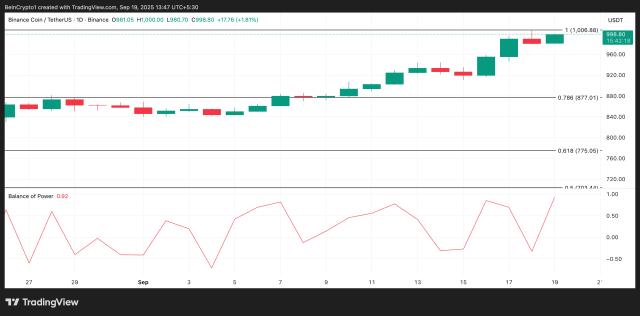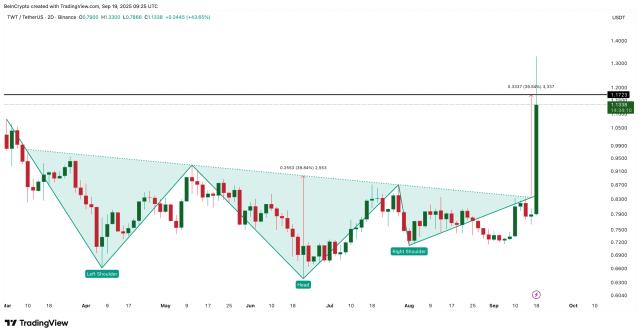The Federal Reserve’s decision to cut interest rates this week shows that the US economy is experiencing volatile market conditions. If history repeats itself, the cryptocurrency market will benefit as the economy unlocks new liquidation .
However, this rate cut may not boost cryptocurrencies as it has in the past. According to experts, political uncertainty and inflation, along with investor caution, could lessen the impact. However, they believe that sectors such as Real Assets (RWAs), decentralized finance (DeFi), and stablecoins are well-positioned to benefit.
Lower interest rates, but with conditions
The Federal Reserve's decision to cut interest rates is usually welcomed by risk-asset investors as a signal that cheaper money is coming. But this time the feeling is somewhat different.
While Bitcoin price remained stable following Powell’s 25 basis point rate cut, its sustained momentum was largely due to institutional support, such as ETF inflows , and commitment from long-term participants.
However, on chain signals soon revealed that not all participants Chia the same optimism.
As BeInCrypto recently reported, the decline in New Address Momentum suggests that retail investors are pulling out . The lower number of new entrants highlights fears of market saturation or an upcoming downturn.
The data reflects a tension that is currently shaping markets—a rate cut liquidation and confirms a weakening economy.
“The reason for yesterday’s rate cut was ‘risk management,’ according to Powell, and that’s an apt term. The FOMC sees its objective as more about protecting growth than preventing inflation, even while acknowledging that both are operational risks. In other words, the specter of stagflation is troubling us again, and it’s not even Halloween yet,” explained Max Gokham, Deputy Chief Investment Officer at Franklin Templeton.
This single move by the Fed forces crypto investors to navigate a more complex landscape than a simple “buy the dip” narrative.
Liquidity liquidation
The Federal Reserve’s rate cut has introduced a dynamic where economic conditions and market liquidation seem to be at odds. While the rate cut acknowledges a weakening economy , it also signals new liquidation that has historically proven to be a catalyst for the cryptocurrency market.
Analysts are closely watching this liquidation factor.
“[Cutting] liquidation injections, lowering the discount rate, and forcing investors back into risk assets. This paradox is why stocks and crypto can rise even when the Fed is essentially confirming slower growth. Right now, the market is more focused on liquidation momentum and the prospect of a soft landing than the pullback from weaker fundamentals,” Kadan Stadelmann, CTO of Komodo Platform, told BeInCrypto.
This view is consistent with the historical record of previous easing cycles, which have been followed by significant crypto price rallies.
Bitcoin , in particular, has a history of leading these events, with its price rising ahead of an expected rate cut. This is often followed by a “sell the news” price drop, as traders who bought into the rumor take profits when the news is confirmed.
“In 2019, BTC rose from $4,000 to $13,000 in anticipation of halvings but did not explode immediately after the announcements. After the halvings in March 2020, as lockdowns gripped the world, Bitcoin crashed before becoming one of the first commodities to recover—even before gold,” Stadelmann added.
However, this week's rate cuts were made under significantly different circumstances than in previous easing cycles.
Inflation, tariffs and uncertainty
While history provides a compelling roadmap for how liquidation can fuel a crypto bull run, the current environment is shaped by significant variables that could disrupt that pattern .
As Jamie Elkaleh, Marketing Director of Bitget Wallet points out, there are two main differences this time around:
“First, the political context: The Fed’s independence is under scrutiny, and that could create credibility issues. Second, the inflation mix is less straightforward, with tariffs and supply chain risks complicating the picture. So while history suggests a rate cut should lift markets, the margin of error is narrower today.”
Political factors add a layer of uncertainty not seen in previous cycles. The recent legal challenge to a Fed governor has raised concerns about political interference in monetary policy, a risk that could undermine market confidence in the central bank.
Moreover, unlike previous cycles driven by strong demand, current geopolitical events , particularly tariffs and supply chain risks, further complicate inflationary pressures.
“Labor market data has softened, and tariffs have added pressure to the inflation outlook. The Fed is walking a fine line: it is easing policy to prevent the recession from becoming more severe, while still acknowledging that inflation has not completely disappeared… the cut is not a ‘green light’ for growth, but a recognition that the economy needs support,” Elkaleh added.
Despite the political and macroeconomic headwinds, the liquidation injection still needs to find a place to invest. Some sectors may benefit more than others.
A look at the winners
While Bitcoin remains a macro play, the real “winners” in this easing cycle can be found in the crypto categories most sensitive to new Capital flows.
For investors, the three main categories that are likely to benefit most immediately and sensitively from the liquidation injection are DeFi, meme coins, and RWAs.
DeFi thrives as lower borrowing costs and the “search for yield” push investors out of less attractive traditional financial products and into on chain money markets. Meanwhile, meme coins are often the first to see a surge in speculative activity.
As Markus Levin, co-founder of XYO, told BeInCrypto:
“Categories like DeFi and meme coins are often the most sensitive to new Capital flows, as retail investor speculation and volume recover first.”
The growth of RWAs is also a compelling story this cycle. The RWA market is expanding, with tokenized treasuries and private credit lending gaining institutional adoption. The hard data supports this growth: Total Value Locked in RWAs increased 31% quarter-on-quarter to $8.2 billion.
Decentralized physical infrastructure networks (DePINs) also have important potential.
“Messari has tracked over 400% growth for the industry by 2024. As of September 2025, CoinMarketCap’s portfolio page for DePIN shows a current total market Capital of over $37 billion. The World Economic Forum predicts it could expand to trillions by 2028, reshaping computation through a more distributed infrastructure,” Levin added.
Meanwhile, stablecoins will grow significantly, Vai as the foundation for much of the on- chain economy.
The story of finding profit
As traditional financial products like government bonds become less attractive in a low-interest rate environment, the yields offered by DeFi stablecoin protocols become more attractive.
“Stablecoins are at the center of this story. Lower policy rates reduce yields in traditional cash products, while on chain markets still offer Medium to double-digit returns through lending, structured products, or tokenized T-bills. That relative premium makes stablecoins more attractive as a store of liquidation and a spendable currency,” Elkaleh explained.
As the cost of money falls, demand shifts to where the yield is highest.
“With interest rate cuts expected to continue through the end of the year, short-term bonds may become less attractive than on chain products that encapsulate credit, Staking, or a premia basis. This could support stablecoin deposits. As a result, we expect a shift to tokenized cash equivalents and yield-generating stablecoins , along with tighter integration with exchanges as issuers chase scale,” Gokham added.
This new reality presents a significant test for the crypto market. The true measure of this easing cycle will be whether emerging on chain sectors can fully capitalize on the liquidation impulse and demonstrate their resilience in an uncertain macro environment.





